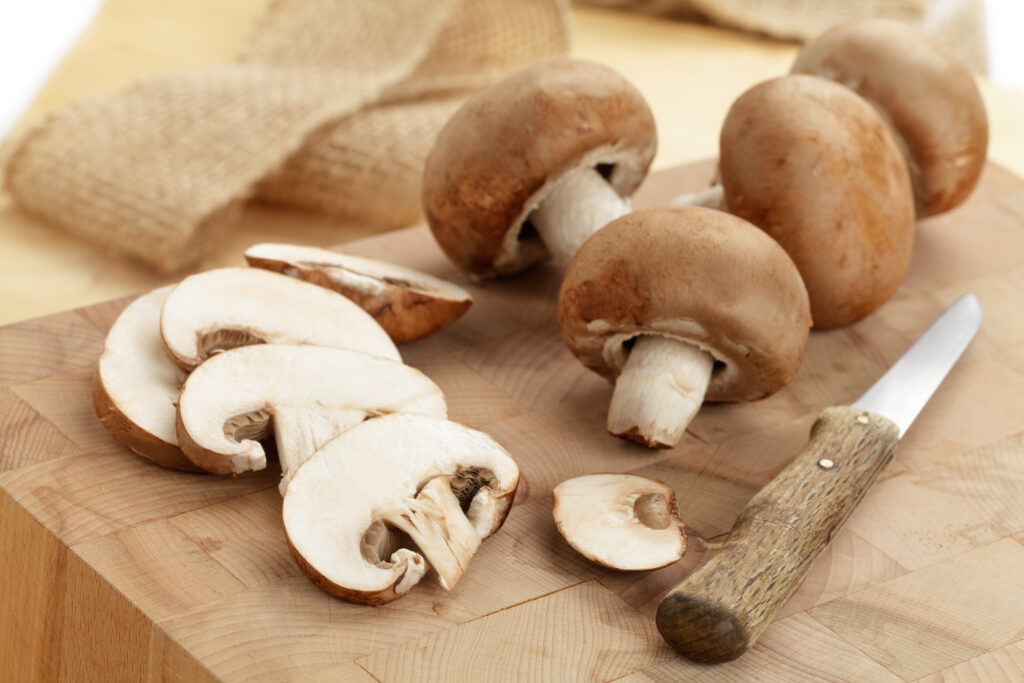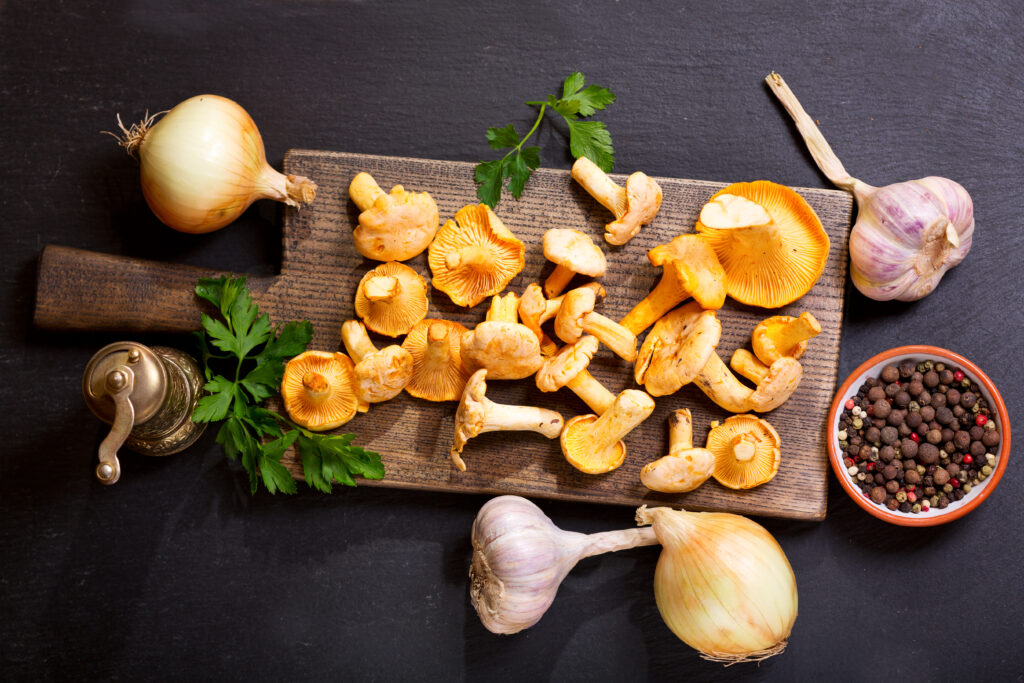
As practitioners, we encourage our patients to eat more brightly colored, phytonutrient-rich fruits and vegetables, and there’s no question that color is strongly correlated with nutrient content. But we should not overlook nature’s white, tan, and brown-pigmented delights.
And by that, I mean mushrooms!
Edible mushrooms contain diverse immunoregulatory compounds, like chitin, β-glucans, sterols, terpenes and terpenoids, amino acid derivatives and fungal immunomodulatory proteins (FIPs). These compounds may be considered “myconutrients”.
Further, many types of mushrooms are capable of producing vitamin D, a nutrient that’s on many peoples’ minds these days.
When it comes to medicinal properties, it is often the less edible mushrooms—Reishi (Ganoderma lucidum), Turkey Tail (Trametes versicolor), Cordyceps (Cordyceps sinensis) and the like—that get the most attention. But many common culinary mushrooms also pack a lot of medicinal punch.
“Mushroom-derived β-glucans may ameliorate the cytokine storm that causes Acute Respiratory Distress Syndrome (ARDS) as seen with COVID-19.”
–Emma J. Murphy, Athlone Institute of Technology, Athlone, Ireland
Here we’ll focus on the immune supportive benefits of three commonly available edible mushrooms: the White Button mushroom (Agaricus bisporus), Shiitake (Lentinula edodes), Maitake or Hen of the Woods (Grifola frondosa).
Other edible species like Oyster (Pleurotus ostreatus), Porcini (Boletus edulis) and Lion’s Mane (Hericium erinaceus) also possess many of the same antioxidant and anti-viral properties. But in many areas, these are not as accessible, and therefore they’re less likely to make it onto patients’ plates.
Vitamin D Production
Mushrooms are saprophytes; they derive their energy from decomposing plant material. As such, they don’t require sunlight to grow and they don’t contain chlorophyll.
However, when they are exposed to UV light, many mushrooms have the unique ability to convert ergosterol—which they produce in large quantities– into vitamin D2. In fact, outside of a specific type of lichen, mushrooms are the only non-animal sources of naturally-occurring vitamin D (aside from synthetics).
This ability to produce vitamin D2 from ergosterol persists even after the mushrooms are picked, provided they’re exposed to UV light. Sliced button mushrooms exposed to sunlight can produce vitamin D2 in quantities high enough to raise serum 25(OH) vitamin D levels and improve bone density in rats (Calvo, et al. Osteoporosis Int. 2013).

While vitamin D3 from animal sources (fatty fish, eggs, liver) is the preferred form of Vitamin D for supplementation, eating mushrooms exposed to UV light can be effective in raising 25(OH) vitamin D. This was recently shown in a study of healthy, recreationally active, but vitamin D-deficient human volunteers (Pinto et al, J Int Soc Sports Nutr. 2020).
In an earlier study, researchers at the University Medical Center, Freiburg, Germany, randomized 25 young, healthy subjects, with baseline 25(OH) vitamin D levels of 50 nmol/l or lower, to three treatment groups. The first group had daily servings of an experimental mushroom soup made from UV-B irradiated button mushrooms, giving a daily dose of 28,000 IU (700 ug) vitamin D2. The second group got a vitamin D2 supplement (28,000 IU), and the the third group got a placebo supplement.
After two weeks, the subjects in the mushroom soup group showed significant increases in serum 250 (OH) D levels, compared with those taking the placebo. The vitamin D surge provided by the soup was was roughly equivalent to the increase seen with the D2 supplement. The study elegantly demonstrates the bioavailability of vitamin D2 from culinary mushrooms (Urbain P, et al. Eur J Clin Nutr. 2011).
For most of our patients, especially those who are severely vitamin D deficient, simply eating mushrooms will not obviate the need for sun exposure and/or supplementation with other forms of vitamin D.
UV-B is Key
This is because most commercially available mushrooms are grown in dark environments and mushrooms need to be exposed to UV-B in order to convert their ergosterol to vitamin D. Further, some researchers argue that vitamin D2—the type produced by fungi—is not the ideal form for humans.
While UV-exposed mushrooms do produce significant amounts of vitamin D—for example, Crimini mushrooms (Agaricus bisporus) can produce over 12 IU/g—one would still need to eat large quantities of mushrooms very frequently to correct a vitamin D deficiency.
That said, culinary mushrooms do represent a good option for raising vitamin D levels in strict vegans and for people who are unable to tolerate exposure to sufficient sunlight. The latter, of course is the most basic way for humans to achieve optimal vitamin D.
The caveat, of course, is that the mushrooms need to be exposed to UV light. There are companies marketing what they claim to be UV-exposed “Vitamin D” mushrooms. That’s a convenient option, though it can be a challenge to separate the marketing hype from the reality. Patients with a DIY inclination can make their own, simply by leaving store-bought mushrooms out in the sun for extended periods.
According to mushroom expert Paul Stamets, 100 grams of Shiitakes will produce 46,000 IU of vitamin D2 per gram after 8 hours of sun exposure. This increases to a stellar 267,000 IU per gram, after 14 hours.
Secretory IgA & Immune Function
A diet rich in mushrooms can increase the production of Secretory Immunoglobulin A (SIgA), while enhancing gut microbial diversity, and reducing a range of pro-inflammatory markers. All of this improves the health and integrity of the gut mucosal lining.
Researchers at the University of Western Sydney, Australia, studied the impact of dietary intake of Agaricus bisporus (White Button Mushrooms or WBM) in a cohort of 24 healthy volunteers. For one week, half of the participants added 100 g of blanched WBM to their daily diets, while the others followed their usual dietary patterns.
There’s hardly a human culture on this planet that does not eat mushrooms of one sort or another. The unique “myconutrients” in mushrooms contribute to their savory umami flavor profile, making mushrooms very desirable.
A daily plate of mushrooms clearly accelerated the secretion of salivary SIgA. At the end of the first week, SIgA production was increased by 53% among the mushroom-eaters; there was no change from baseline among those following their previous eating patterns. One week after cessation of the experiment, those who’d eaten the mushrooms showed a 56% higher SIgA level than at baseline, though this returned to baseline levels by the 3rd week (Jeong SC, et al. Nutrition, 2012).
Secretory Immunoglobin A (SIgA) provides the first line of defense against pathogens at mucosal surfaces. Given the widespread prevalence of SARS-CoV-2 and other infections these days, we want to do all that we can to bolster our patients’ SIgA production.
Mushrooms may also play a role as prebiotics, by virtue of their unique structural polysaccharide, chitin (a long-chain polymer of N-acetyl glucosamine). Chitin acts as a prebiotic fiber and has been demonstrated to improve gut microbial diversity, a key factor in immune system health (Jayachandran M, et al. Int J Mol Sci. 2017).
In a rodent study, a diet of white button mushrooms was associated with an increase in microbial diversity, a reduction in inflammatory cells and decreased colitis (Varshney J, et al. J Nutr. 2013)
Anti-Viral Effects
While there are no studies looking at edible mushroom consumption as a way of mitigating the SARS CoV-2 pandemic, there are several studies looking at the effects of mushroom-derived compounds on a range of other viruses, such as influenza, hepatitis C virus, dengue and HIV.
Shiitake mushrooms, for example, contain many bioactive compounds with diverse pharmacological activities in vitro and in vivo. In a rodent study, Lentinula edodes (Shiitake) mycelia showed broad antiviral activity against influenza viruses, inhibiting their growth early in the infectious process, possibly blocking viral entry into host cells, and stimulating interferon (Kuroki T, et al. Frontiers in Microbiology. 2018).
Mushroom β-glucans could reduce the production of IL-1β, IL-6, and NF-kΒ, while simultaneously reducing oxidative stress.
The dietary intake of WBMs can enhance natural killer cell activity, promote dendritic cell maturation, antigen-presenting function, and increase the expression of interferon-gamma and TNF-alpha. Tufts University researchers published these obervations more than a decade ago, concluding that consumption of WBM may even increase innate immunity to tumors and viral infections (Wu D, et al. J Nutr. 2007.137:1472-7).
A recent paper explores the effect of Shiitake-derived β-glucans in regulating pro-inflammatory cytokines. Using pulmonary alveolar cell culture models, Emma J. Murphy and a team of researchers in Athlone, Ireland, showed that the mushroom β-glucans could reduce the production of IL-1β, IL-6, and NF-kΒ, while simultaneously reducing oxidative stress and attenuating both early and late-stage apoptosis.
Though still preliminary, these findings do have implications for COVID-19. Much of the lung tissue damage occurring in acute cases is thought to be a result of the intense cytokine storm that follows initial infection. The Irish researchers suggest that mushroom-derived β-glucans “may ameliorate the cytokine storm that causes Acute Respiratory Distress Syndrome (ARDS) as seen with COVID-19.” (Murphy EJ, et al. Sci Tot Environ. 2020).
Anti-Oxidant Effects
Glutathione and ergothioneine are two powerful anti-oxidants that are concentrated in mushrooms, especially in Porcini and Lion’s Mane. This may account for their neuroprotective effect in a range of neurodegenerative diseases.
Ergothioneine is a unique sulfur-containing amino acid that is not synthesized in humans and is only available from certain dietary sources, especially fungi. The good news is that cooking does not seem to significantly affect the levels of glutathione and ergothioneine (Kalaras MD, et al. Food Chemistry, 2017)
Mushrooms are also rich sources of trace micronutrients that support immune function, including selenium, zinc and copper as well as riboflavin and niacin.

Culinary Considerations
There are reasons why mushrooms have a cherished place in culinary traditions all over the world. There’s hardly a human culture on this planet that does not eat mushrooms of one sort or another. The unique “myconutrients” in mushrooms contribute to their savory umami flavor profile, making mushrooms very desirable. Their fibers produce a dense, meaty texture that provides a great alternative to meat, especially when grilled.
When choosing mushrooms to cook, look for ones where the flesh is not mushy, slimy or discolored. Use a damp cloth to remove any dirt or particulate matter, and avoid submerging them in water. Store them in a paper bag, which allows them to breathe.
Raw mushrooms contain a mild toxin, agaratine, which is destroyed by heat. Although people rarely fall ill from eating raw mushrooms, they are much better if they are cooked. As previously mentioned, cooking does not destroy the glutathione, ergothioneine, or other myconutrients.
Mushrooms may be sautéed, grilled or roasted. The simplest preparation is to toss them with a little olive oil, sea salt and minced garlic, and roast for 20 minutes in a 370-degree oven. Their umami flavor really comes alive if they’re finished with a squeeze of fresh lemon juice. Oven roasted mushrooms can then be used in omelets, miso soup, stews, stir-fries, salads, and grain bowls.
END
Sally LaMont, ND, LAc, is a naturopathic doctor and acupuncturist with over 30 years of experience in functional medicine. She practices at the Marin Natural Medicine Clinic in Larkspur, CA, and specializes in a range of digestive problems, thyroid, adrenal and female hormonal imbalances, brain fog and early dementia, and other chronic diseases.
Dr. LaMont earned her ND in 1981 from the National University of Naturopathic Medicine and her Master of Science in Oriental Medicine in 1986 at Emperor’s College of Traditional Chinese Medicine. She completed advanced training in The Bredesen Protocol to Prevent and Reverse Cognitive Decline through the Institute for Functional Medicine and the Buck Institute of Aging.
As Executive Director of the California Naturopathic Doctors Association, Dr. LaMont led the successful legislative campaign to license naturopathic doctors (NDs) in California. Her love of cooking and firm belief in food as medicine inspired her newest project, Dr. Sally’s Kitchen, an educational website offering “Rx Recipes” and “Food Pharmacy” guidance for patients and practitioners alike.







